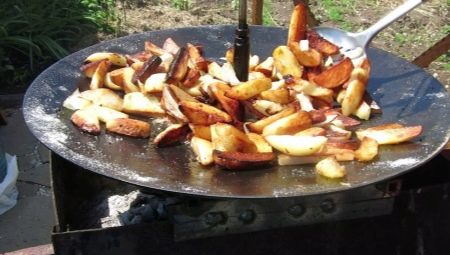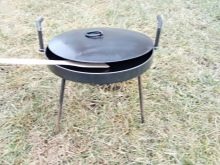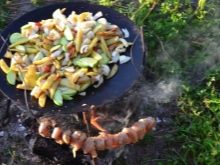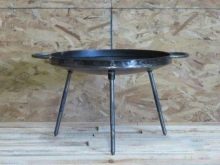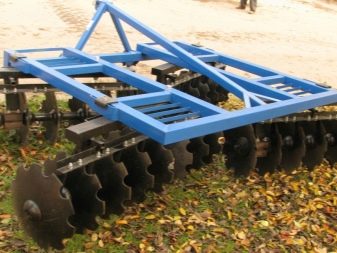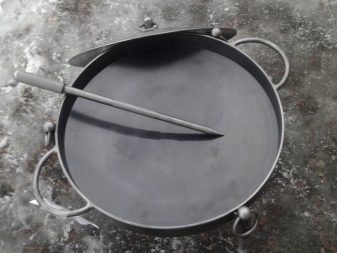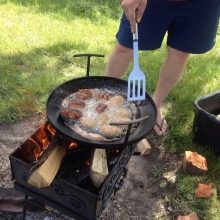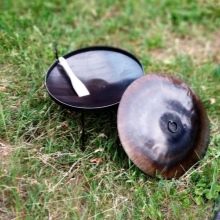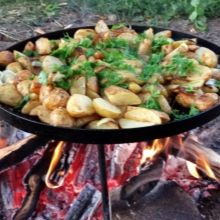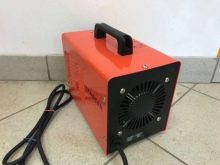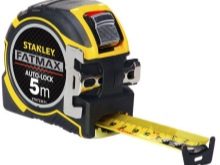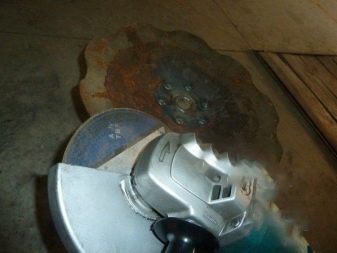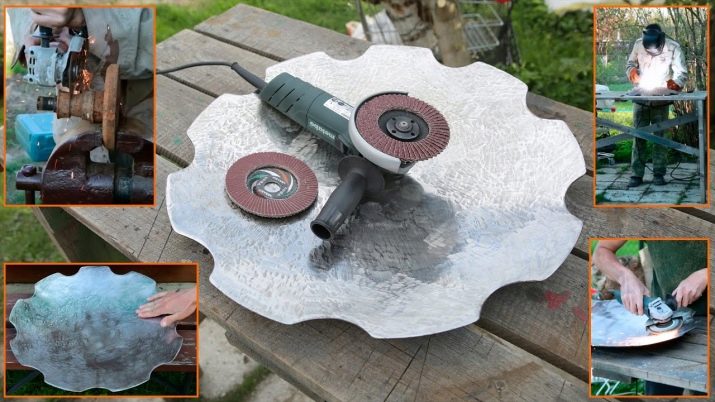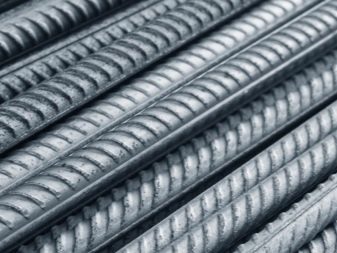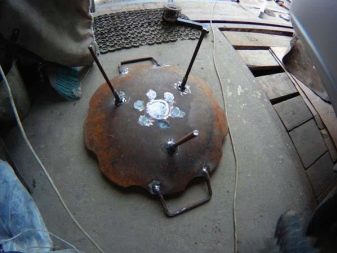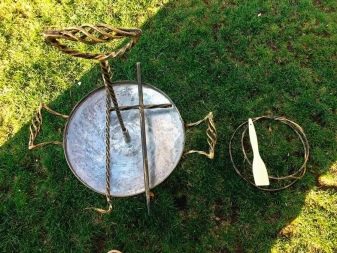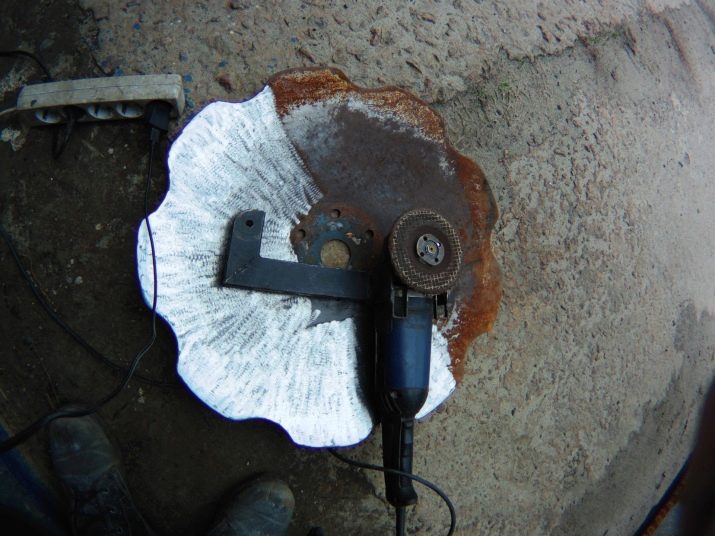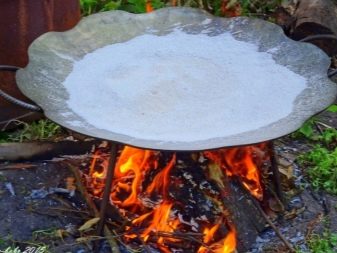Frying pan - a kitchen fixture designed for frying and stewing food. It has a flat or semicircular shape of the bottom part. It can be equipped with a handle for holding during heating. The main materials from which the pans are made are: steel, cast iron, aluminum, stainless steel. There are modifications of pans that can be made by hand. One of the most common methods of manufacturing this device is the alteration of the harrow disk.
Features
Harrow - an agricultural device with which plowing is done. It has a round convex-concave shape. Some harrow species have a cutting edge containing wide teeth. It is made of durable steel with a thickness of up to 1.5 cm. In the center of the harrow, mounting holes are placed, thanks to which it is held in the appropriate position on the driving unit.
The material properties, its thickness and the diameter value make the harrow a suitable blank for making a homemade pan.
A wok made from a harrow is ideal for use in field conditions. It can be installed on improvised bonfire supports, as well as on a special tripod used to hold a round cauldron. With an independent production of a frying pan from a harrow, it is possible to equip additional fasteners, which make it possible to attach supporting legs to it, which significantly expands its functionality and makes it universal.
Instruments
The process of making a frying pan or wok from a harrow is associated with the processing of metal products. Given this, it is necessary to prepare a minimum list of tool accessories that will allow to perform this work. The main toolbox contains:
- welding machine;
- angle grinder;
- hammer;
- vice;
- measuring devices (tape measure or ruler);
- other related tools.
A welding inverter will be needed to eliminate holes, located in the center of the harrow and attach additional elements. The grinder is necessary for cutting metal blanks and processing them, as well as for stripping welds. Before using it, you will need to prepare cutting and grinding wheels, nozzles for stripping and polishing.
When carrying out welding work using a hammer is of paramount importance. With it, slag deposits that occur in the process of overheating of the metal at the point of welding and which penetrate the weld seam are fought off. Defective areas of the joints may be located under these deposits: cracks or voids. Beating slag with a hammer, you can identify these defects and eliminate them.
The presence of a vise is welcome, although not required. They help keep the workpiece in a stationary position, which facilitates the process of its processing. Without a vice at hand, the workpiece can be fixed in any convenient way. Measuring devices are used to make measurements of the dimensional parameters of the blanks, which is necessary in the manufacture of fastening the support legs of the pan.
In the process of reworking the disc harrow in the pan, other tools may be necessary, which is determined by the characteristics of the finished product.
Materials
The main component of the homemade pan is a harrow made of durable thick-walled steel. The remaining elements are designed to give it a proper functional form. The following materials can be used to remove the mounting holes:
- metal plate;
- iron bar;
- bearing balls;
- other available items.
The thickness of the metal plate must match the wall thickness of the harrow. This will allow to fix the mounting holes without disturbing the inner surface of the pan or its outer bottom. The diameter of the iron rod should correspond to the diameter of the holes located in the center of the wok. If its diameter is less than the diameter of the holes, then the extra space between the rod and the inner edge of the hole can be filled with a trim of a pipe with a corresponding diameter or other metal inserts.
If the diameter of the rod is larger than the diameter of the holes, the best solution would be to equalize these values by grinding the rod. Drilling the holes is not considered cost-effective, since the metal from which the harrow is made is thick and durable. Using bearing balls as elements covering the mounting holes in the harrow is the best way to do this. The main difficulty is the search for balls with a sufficiently large diameter.
Suitable elements may be balls from a tractor bearing, which can be found among the parts in the territory of most automotive demolition shops.
To ensure ease of use of the pan it is worth welding U-shaped handles to the edge of its edge. They can be made from reinforcement or iron rod having a small diameter.
Ways to remove holes
Harrow mounting holes, whose diameter ranges from 15-20 mm, are located in the center of the workpiece, which prevents its use as a frying pan. Their elimination with the help of a metal plate can be done in two ways. In the first case, the 2 parts of the plate are welded on both sides of the harrow so that the holes are completely blocked. Procuring is performed around the perimeter of the plate elements, which eliminates the occurrence of a leak.
The area of the inner and outer plates is cleaned using a grinder and a corresponding nozzle. Particular attention is paid to the internal welds, as they will come into contact with the products that are prepared in the pan. The presence of cracks and voids in the seams will contribute to the ingress of food particles into them, which is undesirable. The second way to use a metal plate to remove the holes in the harrow is to make round cover elements, the diameter of which corresponds to the diameter of these holes.
The contour of each hole is transferred to the surface of the plate, after which the sawing is performed using a grinder and a cutting wheel. The resulting "pills" are inserted into the holes and scald along the line of their contact with the inner edges of the holes. When using a metal rod, the task of cap holes is simplified. The rod is inserted into the hole and scalded. Then its excess parts are cut. To facilitate the implementation of this work it is possible to saw off in advance from the rod of the workpiece, the length of which is equal to the wall thickness of the harrow.
If there are bearing balls of the appropriate diameter, the holes are removed as follows: the ball is inserted into the hole so that it is not visible in the inside of the pan. Perform welding. The recess that forms above the welded ball is filled with the liquid metal of the melting electrode. In the finished form, the pan, in the manufacture of which bearing balls were used, will have rounded protrusions at the bottom.These protrusions serve as supporting legs, allowing you to set the pan with a semicircular bottom on a flat surface.
For information on how to make a pan out of a harrow disk, see the following video.
The final stage
In order to use the pan from the harrow, it could be used in field conditions, four lengths of a pipe at least 10 cm long are welded to its bottom. The distance between them should be equal, which will ensure efficient distribution of loads. Supporting legs will be inserted into these tubes, the height of which should allow placing the pan over the fire. At the final stage of the manufacture of the frying pan from the harrow, a thorough cleaning of the inner side surface and its subsequent polishing is carried out.
Any coatings applied to the harrow should be removed, because when heated, they will release toxic substances, the presence of which is incompatible with cooking for humans.
When grinding a surface, it is important to maximize smoothness.. The absence of scratches and grooves left by abrasive materials will prevent food from sticking to the surface of the pan and the subsequent burning of food. Since the harrow is the cutting element of the tractor plow, it is necessary to carefully treat its outer edge. With the help of the grinding wheel and grinder, the edge of the pan is rounded.
Next, you need to make a primary calcination at the stake, which will reveal structural shortcomings, if any.
